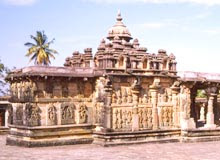Hoysaleswara Temple - Information
Location: Halebid, Karnataka
Built in: 12th century
Dedicated to: Lord Shiva
Attraction: Exquisite architecture
Significance: One of the largest temples dedicated to Lord Shiva in South India
How to reach: One can easily reach Hoysaleswara Temple by taking regular Buses or by hiring taxis from anywhere in Karnataka
Hoysaleswara Temple History
Hoysaleswara Temple is one amongst the largest shrines that are dedicated to Lord Shiva in South India. In the 12th century, the temple was built during the rule of King Vishnuvardhana of Hoysala Empire. The construction of this marvelous shrine got completed in 1121 CE. Located at Halebid, Hoysaleshwara Temple can be easily reached from Belur (16 kms), Hassan (31 kms) and Mysore (149 kms) in Karnataka. Apart from these cities, Halebid is accessible from almost every city and town of Karnataka by regular buses and hired taxis.
It is believed that the temple derived its name from Vishnuvardhana Hoysaleswara, the presiding ruler in those times. However, the erection of the temple was started and sponsored by the affluent Shaiva citizens (mainly Ketamalla and Kesarasetti) of Halebid. At the time of construction, a tough competition held between Hoysaleswara Temple and Chennakesava Temple at Belur. Hoysaleswara Temple witnessed ransack of loot and raid by the Muslim invaders in the early 14th century. After the horrifying incident, the temple was reduced to rubble and fell into the state of sheer neglect.
Hoysaleswara Temple has two shrines, one dedicated to Hoysaleswara and another for Shantaleswara (named after Shantala Devi, queen of King Vishnuvardhana). Standing on a raised platform, the temple is made out of Chloritic Schist (Soapstone, also known as potstone). Both of the shrines are located next to each other, facing the east direction. The shrine comprises the Shiva lingam (phallic form of Lord Shiva), the universal symbol of Lord Shiva.
Besides the other shrines, there is one shrine that is dedicated to Lord Surya. Here, Sun God is depicted in the 7 ft tall image. The halls comprise huge images of Nandi, the attendant of Lord Shiva. Hoysaleswara Temple stands as a testimonial of the bygone era. The outstanding structure of the temple has been accredited for being the epitome of Hindu architecture.
Hoysaleswara Temple - Architecture
The remarkable structure of this temple has been acclaimed as a perfect exemplar of Hindu style of architecture. Its architecture is often regarded as the 'supreme climax of Indian architecture'. In the exteriors, many projections and recesses in the walls make the structure quite complex; in contrast to it, the interiors appear simple. The exterior walls of the temple have a splendid assortment of stone sculptures.
Hoysaleswara Temple is particularly known for its wall sculptures that are imprinted right from the outset of the outer wall. Opening with an image of dancing Ganesha on the left hand side of the south entrance, the series ends with a different image of Ganesha on the right hand side of the north entrance. The whole collection has not less than 240 images. The most complicated of all sculptures, are traceable in the beams, over two of the entryways, one on the southern entryway and other on the eastern entryway.
The interiors of the temple are quite plain except for the lathe turned pillars that dash in rows flanked by the north and south doorways. Making the forefront of the each shrine, the four pillars are the most elaborate having 'madanika' sculptures in their brackets. The massive temple has four porches serving as its doorways. Generally, only one porch is left open for entry that lies in the north.
The superstructure on the shrines is known as 'Sunakasi', which used to be a row of ornamented miniature roofs on top of the attics of the hall, are all gone astray. Even the towers of the shrines are not there. The temple was constructed at a height to grant adequate horizontal and vertical space to illustrate large and small sculptures.
Hoysaleswara Temple - Garuda Pillar
Garuda Stambha (Pillar) is an attention-grabbing structure of Hoysaleswara Temple. Garudas were known to be the selected bodyguards of the kings and queens. They used to live and move with the Royalty with the sole aim to defend their master. At the death of their master, they committed suicide. In the southern side, the pillar demonstrates heroes flanking knives and cutting their own heads. The inscription on the pillar commemorates Kuruva Lakshma (bodyguard of Veera Ballala II)


No comments:
Post a Comment